Bulletin – March 2019 Payments New Payments Insights from the Updated Retail Payments Statistics Collection
- Download 437KB

Abstract
The Reserve Bank has significantly expanded the retail payments data that it publishes from 61 to around 300 series. This followed a project conducted in consultation with the industry to update the underlying statistical collection. The new data provide additional insights into Australians' payment behaviours, particularly in the context of the shift towards electronic methods of payment away from cash and cheques. This article discusses some of the new series being published by the Bank.
Introduction
The Reserve Bank has published monthly statistics on Australian payment systems from its Retail Payments Statistics (RPS) collection since 2002, with some series dating back as far as 1985. These statistics cover credit and debit card systems, the direct entry system, the ATM system and cheque payments. The data are reported to the Bank every month by financial institutions and payment service providers.
The RPS collection helps the Bank to monitor payments activity in a timely and detailed manner. This information helps to inform the Bank's policy advice to its Payments System Board, which is responsible for promoting efficiency and competition in Australia's payments system and contributing to the overall stability of the financial system. The published RPS series – available on the Bank's website – are selected aggregates of the detailed data in the RPS collection.
The Bank recently completed a major project to update the RPS collection, which had been largely unchanged in terms of the type of data collected since 2002.[1] The primary motivation for this work was to ensure that the data collection remained a relevant and valuable source of information for policymakers, the private sector and the wider community. The Bank consulted widely and worked closely with reporting institutions on the updated data collection, and also made the IT systems that support the collection more robust and secure. The Bank is now collecting data on payments made through the New Payments Platform (NPP) and a broader range of data on card payments, which are increasingly prominent payment methods for Australian households and businesses. Series that had become less relevant from a policy perspective – such as separate data on mail and telephone payments – have been discontinued to minimise reporting burden.
Another focus of the review was to ensure that a sufficiently comprehensive coverage of industry activity could be maintained, while reducing reporting burden where possible. As part of this, the Bank started collecting some data from centralised sources, such as from payment system operators directly, eliminating the need for system participants to report individually. In addition, institutions with very small market shares were removed from the survey, while a small number of new reporting institutions were added to make the survey more comprehensive within particular payment systems. Overall, the number of reporting institutions was reduced from 52 to 28.[2]
Changes to the RPS collection will support the Bank's work to understand the evolution of the payments mix in Australia and to promote reliable, secure and low-cost payments services. In addition, from March 2019, the Bank has significantly expanded the payments data it publishes on its website from 61 to around 300 series.[3] All existing series previously published in the statistical tables have been preserved in the new tables and will continue to be published. The Bank has also started publishing some seasonally adjusted payments data along with the original series (see Box A).
This article discusses some of the new series published by the Bank, including additional insights on how individuals and businesses make and receive payments.
Box A: Seasonal Adjustment of the Retail Payments Statistics
Some data exhibit a regular periodic pattern, which is also known as seasonality. Payments data can be highly seasonal, as some significant spending by households and businesses is associated with holidays and other events that tend to occur every year at a predictable time.[4] For example, a significant increase in the use of debit cards and other payment methods is typically observed in December due to Christmas spending, followed by a subsequent fall in January and February (Graph A1). Seasonality can also arise due to other factors, such as the number of trading days in a month.
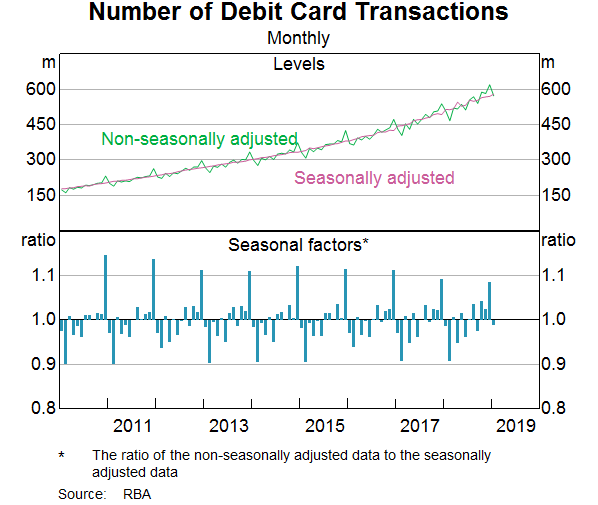
As seasonality can cause significant changes to monthly and quarterly payments activity, it is important that policymakers and other analysts distinguish between seasonal effects and other drivers of payment activity (such as behavioural changes and policy interventions). Seasonal adjustment is a statistical technique that helps identify seasonality in time series data and is used globally by many statistical agencies and policy institutions.[5] Seasonally adjusted series are less volatile than the original series, providing a clearer interpretation of the data (Graph A1).
Although seasonal adjustment can help with data analysis, not all series can be seasonally adjusted, and seasonally adjusted series should be interpreted with care. A monthly series typically requires three to seven years of data to estimate a reliable seasonal pattern; some series introduced in the Bank's revised collection (e.g. data on NPP transactions) do not have a long enough history to meet this requirement.[6] Furthermore, seasonal adjustment can result in small data revisions over time, as the statistical method detects seasonality and changes in the seasonal pattern more accurately as more data are added to the series. Finally, not all payments data require seasonal adjustment; for example, stock measures like number of cheque accounts and credit card limits do not typically display significant seasonal variations.
When available, the Bank typically prefers to use seasonally adjusted data in analysing payments developments. In recent years, this has included showing seasonally adjusted series in publications, speeches and in policy advice to the Payments System Board. As part of the updated collection, the Bank is now publishing seasonally adjusted data in the statistical tables along with the original data. These new data should provide more meaningful insights into high frequency movements and short-term trends in the use of payment methods.
Payment Cards
Credit and debit cards combined are the most frequently used payment method in Australia.[7] Cards are becoming increasingly popular in Australia, reflecting users' preference for convenience and faster payments, and a reduction in card acceptance costs for merchants. The total number and value of card payments have increased by around 11 per cent and 7 per cent each year on average over the past decade, respectively, with growth in debit cards outpacing that in credit cards (Graph 1). Reflecting the growing importance of card payments, the Bank has started to publish new series on how and where card payments are made.
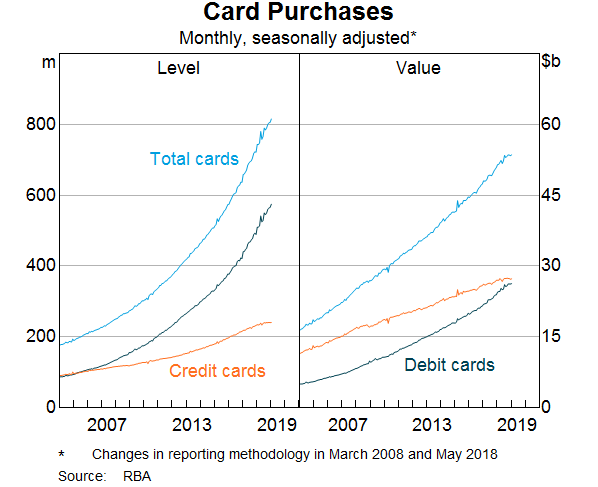
Domestic and international transactions
The Bank is now publishing richer data on the domestic and international uses of credit and debit cards.
The vast majority of card payments by Australians are for domestic payments, although the use of cards for overseas transactions is growing. Domestic transactions currently account for around 95 per cent of the value of card payments on Australian-issued cards. Cards have become increasingly used for low-value purchases in Australia over the past decade, which has resulted in a decline in the average value of transactions for both credit and debit cards, despite general price inflation over this period (Graph 2). The decline in the average transaction size can be partly attributed to the introduction of contactless payments for credit and debit cards, which have made the use of cards for low-value purchases more convenient for both cardholders and merchants.
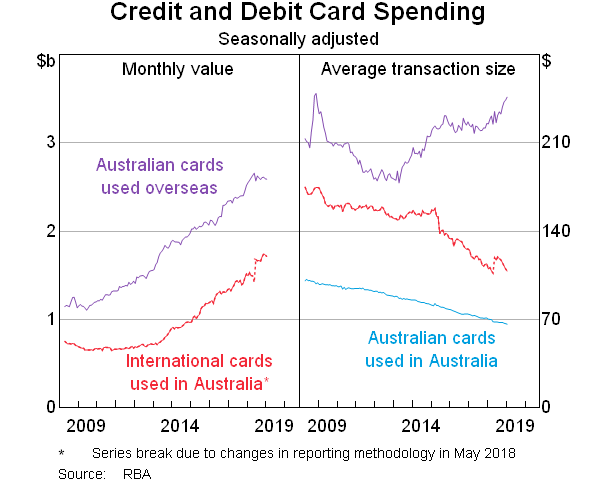
Card spending by Australians overseas has more than doubled over the past decade (Graph 2). This is consistent with both the increasing popularity of online shopping on international websites and an increase in short-term resident departures over the period. Australians spend on average around $250 on an overseas purchase. This is significantly higher than the average size of domestic transactions at around $65, partly because airfares, accommodation expenses and other relatively high-value goods and services tend to account for a sizeable share of international card spending for individuals.
The Bank has also started publishing data on card spending in Australia conducted on international cards, which accounts for around 3 per cent of the value of all card payments in Australia. This includes spending by international tourists in Australia and, to a lesser extent, online shopping on Australian websites by foreigners. Over the past few years, there has been strong growth in international card spending in Australia. This is consistent with an increase in the number of international tourists visiting Australia, along with an increase in average tourist spending.[8] Greater acceptance of overseas-issued cards by Australian merchants has also likely contributed to the increase in international card spending in Australia.
In-person and remote transactions
The Bank is now publishing data on in-person and remote transactions with credit and debit cards to provide greater clarity on the way cards are used. In-person transactions refer to payments made at a point of sale, where the card, mobile phone or other device containing the card credentials (e.g. a payments-enabled smart watch) interacts with an acceptance technology to authenticate the transaction. In contrast, remote transactions include online payments, purchases made through a mobile app, and by mail and telephone. The growing popularity of online shopping and the increasing availability of mobile apps that allow users to make payments with pre-authorised card information (e.g. ride-sharing apps like Uber), have resulted in the share of remote payments rising from 12 per cent in 2008 to 16 per cent in 2018 (Graph 3).

Personal and commercial use of credit cards
Recognising that credit cards are often used differently by households and businesses, the Bank has started publishing data on personal and commercial credit card transactions separately. The new data suggest that 19 per cent of the total value of credit card transactions are undertaken on commercial cards (Graph 4). As businesses typically repay credit cards in full within their interest-free period, commercial cards account for only 6 per cent of total balances accruing interest. These shares have remained largely constant over the past decade.
The average transaction size on commercial credit cards has increased steadily over the past decade to around $360. By comparison, not only is the average transaction size on personal credit cards notably lower at around $100, it has also declined over the past decade. Commercial credit cards are typically used to manage business expenses, which can be significantly higher in value than typical personal transactions. There is no material difference in the proportion of international spending between personal and commercial cards.
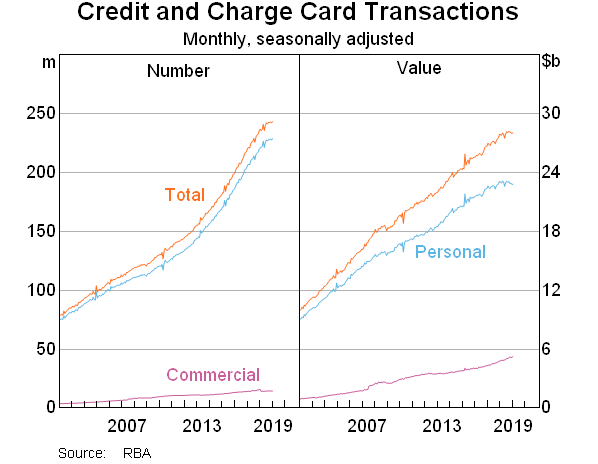
Prepaid scheme cards
Over the past few years, gift cards and reloadable travel cards have become increasingly popular among households and businesses. To provide clearer insights into the prepaid card market, the Bank is now publishing data on prepaid scheme card transactions, separate to debit card statistics (see Box B).[9] There are currently around 9.4 million prepaid scheme cards on issue in Australia with $1.8 billion of stored value held on them, or $190 per card on average.
Prepaid scheme cards are commonly used for international transactions, which account for around half of the total value of spending on these cards. By comparison, just 3 per cent of debit card spending is on overseas purchases.
NPP Payments
The Bank started publishing data on NPP payments in August 2018, showing the number and value of transactions since the system became publicly available in February 2018.[10] There has been strong growth in NPP transactions as banks have progressively rolled out fast payments functionality to their customers. The total monthly number of NPP payments reached around 13 million in January, more than double the monthly number of cheque payments, and the value of NPP payments was around $11 billion (Graph 5). The average value of NPP transactions was just over $800. From March 2019, the Bank has also started to publish NPP payments by payment method. The NPP currently supports two payment methods – basic transfers (known as Basic Single Credit Transfers) and Osko payments, which offer richer functionality.[11] The Bank expects to publish data on additional NPP payment methods as they become available.
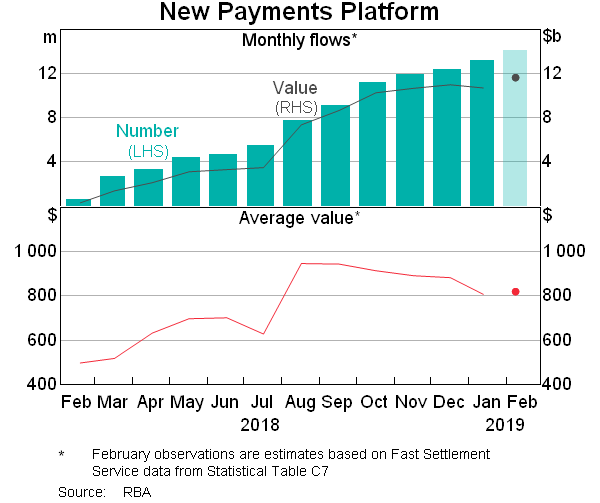
Box B: Series Breaks in the Published Retail Payments Data
The recent changes to the RPS collection have resulted in breaks for a small number of series in the published data in May 2018, when the revised reporting methodology was introduced alongside changes in the sample of reporting institutions. After the break points, the series should also be more accurate as a result of an improved understanding of the reporting requirements by institutions. Most published series, however, were not affected by significant series breaks.[12]
There are some particularly notable breaks in the data on direct entry payments. From May 2018, published data for total direct entry payments were around 30 to 40 per cent lower than previously calculated, with debit transfers most heavily impacted. This break was mostly due to a number of institutions improving their reporting of these transactions by excluding various types of internal transfers that had previously been included as direct entry payments.
Another notable break in the data is the exclusion of prepaid scheme cards from the debit card statistics. Prior to May 2018, some institutions reported prepaid scheme cards as debit cards, as the earlier RPS survey did not include a separate category for prepaid cards. As discussed in this article, the Bank is now separately collecting and publishing data on prepaid card transactions. As a result of these changes, the published data for the number of debit card accounts declined by around 20 per cent in May 2018; other debit card data are also lower than previously calculated due to the exclusion of prepaid card transactions.
Cash and Cheques
The use of cash and cheques has been declining for many years as consumers have increasingly adopted electronic methods of payment.[13] Reflecting the decreasing use of cash, use of ATMs has been falling for a number of years. The number of ATM withdrawals has fallen by an average of around 5 per cent per year since 2013 and is now about 35 per cent below its 2008 peak (Graph 6). The average value of an ATM withdrawal has increased over the past decade, in line with the rate of inflation, and is now around $225.
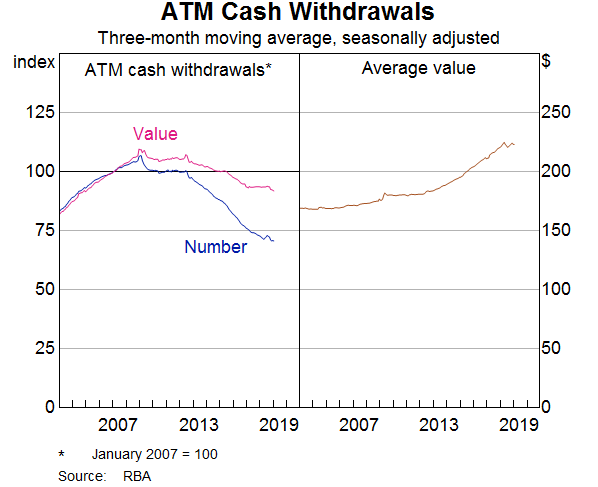
As use of ATMs continues to fall, it will be important to monitor how ATMs are being used. As part of the revised RPS collection, the Bank has started publishing a richer set of information on ATM transactions, including domestic and international use, the type of card used for ATM transactions and balance enquiries.
Most ATM withdrawals in Australia are undertaken with Australian-issued cards. Overseas cash withdrawals by Australians account for around 3 per cent of the value of all ATM withdrawals on Australian-issued cards. Similarly, around 3 per cent of all ATM withdrawals in Australia use international cards, although the average withdrawal amount on these cards tends to be relatively high at over $400.
Nearly all ATM withdrawals in Australia are made using debit cards, reflecting that most Australians hold a debit card and have access to a fee-free ATM at many locations. Around 3 per cent of the number of ATM withdrawals in Australia are made using credit cards, which likely reflects that many credit cards attract relatively high cash advance fees and interest rates for withdrawing money from an ATM. The average withdrawal on credit cards is higher than that for debit cards at around $285.
Since late 2017, cardholders have been more actively using ATMs owned by financial institutions that they do not bank with or independent deployers (Graph 7). Around half of all withdrawals are now undertaken at ATMs owned by other financial institutions and independent deployers, up from around 40 per cent in recent years. This notable shift in ATM preferences can be attributed to the decisions of a number of banks to remove their ATM direct charges for debit card withdrawals and balance enquiries in late 2017, greatly increasing the number of fee-free ATMs for Australian cardholders.[14] The removal of direct charges may also have contributed to a slowdown in the rate of decline in the number and value of ATM withdrawals since late 2017. The number of cash withdrawals fell by around 3 per cent in 2018, less than the average annual rate of decline of around 7 per cent observed in previous two years.
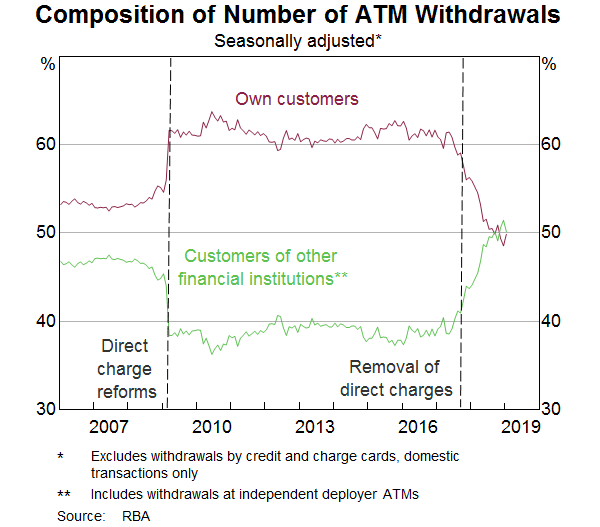
The Bank is also now publishing data on transactions conducted at ATMs owned by non-bank independent deployers. Independent deployer ATMs tend to be found in convenience locations like petrol stations and licensed venues, and typically levy direct charges for withdrawals and balance enquiries. Around 20 per cent of ATM withdrawals are made at ATMs owned by independent deployers; the average withdrawal at these ATMs is around $180, lower than the average value of withdrawals at financial institution ATMs of $240 (Graph 8). Only 7 per cent of balance enquiries are made at ATMs owned by independent deployers.

Cheque use has been declining for many years driven by changing preferences and payment innovations. As more businesses and other payees stop accepting cheques and the per-transaction cost of supporting the cheque system continues to rise, it will be increasingly important to identify which segments of the market continue to rely on cheques.[15] To this end, the Bank has expanded the data that it publishes on cheques to include splits by personal and commercial customers.
Around 60 per cent of all cheques are written by commercial customers. However, of the 12 million cheque accounts open at the end of January, around 80 per cent were held by personal customers. This may reflect the fact that many personal customers were provided with a free cheque book facility when they opened an account with a financial institution; these cheque accounts may not necessarily be actively used.
The total number of cheque payments fell by 22 per cent in 2018 (Graph 9). While this decline was driven largely by commercial cheques, the number of personal and financial institution (i.e. ‘bank’) cheques also declined. Overall, the number of cheque payments has fallen by around 80 per cent over the past decade. More recently, the value of cheque payments has also started to decline noticeably, led by a significant fall in the value of financial institution cheques. This has been driven primarily by the real estate industry moving towards electronic conveyancing systems such as Property Exchange Australia (PEXA), replacing the need to use cheques for property settlement (Graph 10).
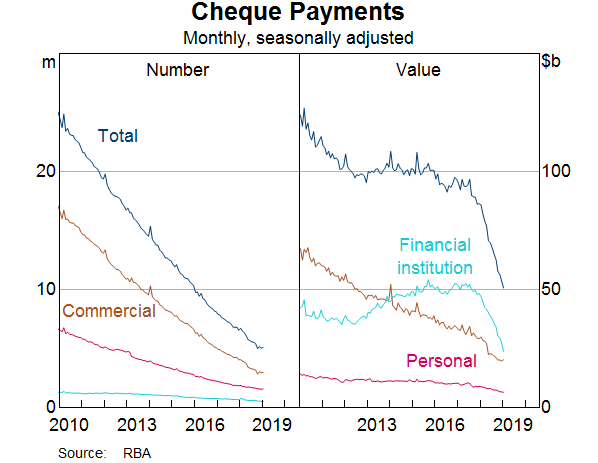
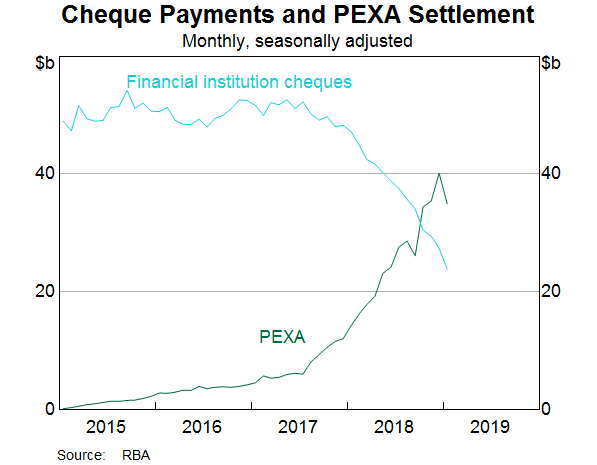
Conclusion
The project to revamp the RPS collection will help maintain the relevance and accuracy of this important data set on Australians' payments behaviours. The expanded set of published data now includes seasonally adjusted estimates and more disaggregated series on payments activity. This information can provide greater insights into the changing payments mix and support research by policymakers, the private sector and the wider community. The Bank is grateful for the cooperation of all those institutions that have been involved in the update of the RPS collection.
Footnotes
The authors are from Payments Policy Department. The authors would like to thank Tim West and many other colleagues for their significant contributions to the Retail Payments Statistics review project. [*]
In 2008, the Bank made some small changes to the collection, mainly to separate the reporting of credit and debit card data for the international schemes. [1]
See Box B for discussion on statistical breaks for a small number of series. [2]
A link to the new statistical tables can be found at the end of this article. Further updates to the data can be found on the Bank's website <https://www.rba.gov.au/statistics/tables/>. [3]
Holidays that do not fall on the same day every year (such as Easter) can also induce seasonality. [4]
The Bank uses the X-13ARIMA-SEATS (X13) seasonal adjustment program to adjust payments data. X13 was developed by the US Census Bureau. For more information, see United States Census Bureau (2019). [5]
The Bank will look to publish additional seasonally adjusted data when the series have a long enough history. [6]
‘Credit card’ in this article refers to both credit and charge cards. According to the Bank's triennial Consumer Payments Surveys, credit and debit cards overtook cash as the most common method of payment in 2016 (Doyle et al 2017). [7]
See Australian Bureau of Statistics (2019) and Tourism Research Australia (2019) for more information. [8]
Prepaid scheme cards include transactions that are routed over a card scheme network (e.g. eftpos, Mastercard, Visa). The data do not include transactions made on prepaid cards that are not processed over a scheme network, such as store cards or closed-loop gift cards (e.g. Westfield gift card). [9]
The Bank also publishes monthly data on the number and value of interbank NPP payments settled in the Fast Settlement Service, available at <https://www.rba.gov.au/statistics/tables/xls/c07hist.xls>. [10]
See Rush and Louw (2018) for more information on NPP and Fast Settlement Service functionalities. [11]
Reporting institutions were asked to report data under the previous and the new methodology concurrently for three months, which enabled the Bank to estimate the size of series breaks. For most series, the size of the breaks in the data are less than 2 per cent. [12]
For more information on developments in the use of cash see Davies et al (2016), and for changes in the payment mix see Doyle et al (2017). [13]
For more information on recent developments in the ATM industry, refer to Mitchell and Thompson (2017). [14]
For more information on ongoing cheque use, refer to Tellez (2017). [15]
References
Australian Bureau of Statistics (2019), Overseas Arrivals and Departures, Australia. Available at <http://www.abs.gov.au/AUSSTATS/abs@.nsf/mf/3401.0>.
Davies C, M Doyle, C Fisher and S Nightingale (2016), ‘The Future of Cash’, RBA Bulletin, December, pp 43–52.
Doyle M, C Fisher, E Tellez and A Yadav (2017), ‘How Australians Pay: New Survey Evidence’, RBA Bulletin, March, pp 59–66.
Mitchell S and C Thompson (2017), ‘Recent Developments in the ATM Industry’, RBA Bulletin, December, pp 47–52.
RBA (2017), ‘Strategic Priorities for the Reserve Bank's Payments Work’, in Payments System Board Annual Report 2017, pp 39–43.
Rush A and R Louw (2018), ‘The New Payments Platform and Fast Settlement Service’, RBA Bulletin, September.
Tellez E (2017), ‘The Ongoing Decline of the Cheque System’, RBA Bulletin, June, pp 57–66.
Tourism Research Australia (2019), ‘Time series data for international visitors to Australia’. Available at <https://www.tra.gov.au/International/international-tourism-trends>.
United States Census Bureau (2019), The X-13ARIMA-SEATS Seasonal Adjustment Program site. Available at <https://www.census.gov/srd/www/x13as/>.